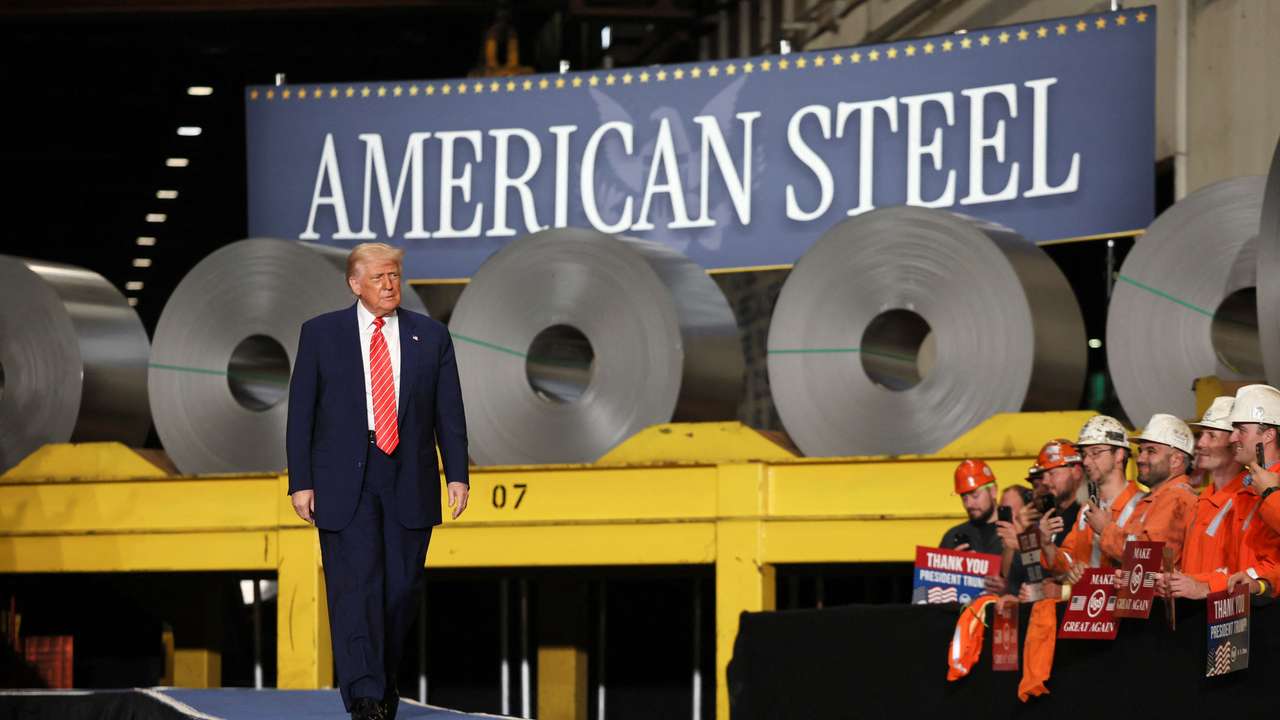Trump says he plans to double steel, aluminum tariffs to 50%

By Jeff Mason
U.S. President Donald Trump said on Friday he planned to increase tariffs on imported steel and aluminum to 50% from 25%, ratcheting up pressure on global steel producers and deepening his trade war.
"We are going to be imposing a 25% increase. We're going to bring it from 25% to 50% - the tariffs on steel into the United States of America, which will even further secure the steel industry in the United States," he said at a rally in Pennsylvania.
The doubling of steel and aluminum levies intensifies Trump's global trade war and came just hours after he accused China of violating an agreement with the U.S. to mutually roll back tariffs and trade restrictions for critical minerals.
Trump announced the higher tariffs just outside Pittsburgh, where he was talking up an agreement between Nippon Steel and U.S. Steel. Trump said the $14.9 billion deal, like the tariff increase, will help keep jobs for steel workers in the U.S.
He later posted on social media that the increased tariff would also apply to aluminum products and that it would take effect on Wednesday.
Shares of steelmaker Cleveland-Cliffs Inc surged 26% after the market close as investors bet the new levies will help its profits.
The announcement drew harsh reactions from U.S. trading partners around the world.
Canada's Chamber of Commerce quickly denounced the tariff hike as "antithetical to North American economic security."
"Unwinding the efficient, competitive and reliable cross-border supply chains like we have in steel and aluminum comes at a great cost to both countries," Candace Laing, president of the chamber, said in a statement.
Canada's United Steelworkers union called the move a direct attack on Canadian industries and workers.
The European Commission said on Saturday that Europe is prepared to retaliate.
"This decision adds further uncertainty to the global economy and increases costs for consumers and businesses on both sides of the Atlantic," a European Commission spokesperson said.
"The EU is prepared to impose countermeasures, including in response to the latest U.S. tariff increase."
Australia's centre-left government also condemned the tariff increase, with Trade Minister Don Farrell calling it "unjustified and not the act of a friend."
Trump spoke at U.S. Steel's Mon Valley Works, a steel plant that symbolizes both the one-time strength and the decline of U.S. manufacturing power as the Rust Belt's steel plants and factories lost business to international rivals. Closely contested Pennsylvania is also a major prize in presidential elections.
The U.S. is the world's largest steel importer, excluding the European Union, with a total of 26.2 million tons of imported steel in 2024, according to the Department of Commerce. As a result, the new tariffs will likely increase steel prices across the board, hitting industry and consumers alike.
Steel and aluminum tariffs were among the earliest put into effect by Trump when he returned to office in January. The tariffs of 25% on most steel and aluminum imported to the U.S. went into effect in March, and he had briefly threatened a 50% levy on Canadian steel but ultimately backed off.
Under the so-called Section 232 national security authority, the import taxes include both raw metals and derivative products as diverse as stainless steel sinks, gas ranges, air conditioner evaporator coils, horseshoes, aluminum frying pans and steel door hinges.
The 2024 import value for the 289 product categories came to $147.3 billion with nearly two-thirds aluminum and one-third steel, according to Census Bureau data retrieved through the U.S. International Trade Commission's Data Web system.
By contrast, Trump's first two rounds of punitive tariffs on Chinese industrial goods in 2018 during his first term totaled $50 billion in annual import value.
This article was produced by Reuters news agency. It has not been edited by Global South World.